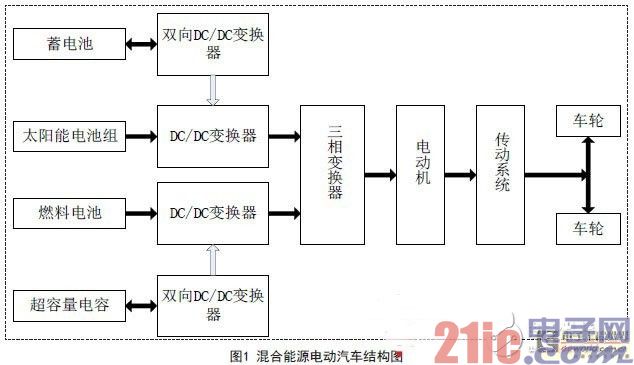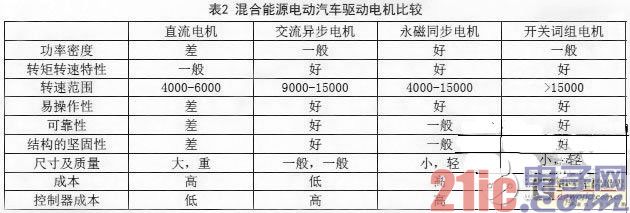1 Introduction This article refers to the address: http:// With the development of the economy, the number of cars has been increasing, and the problem of environmental pollution has become increasingly serious. Therefore, researching energy-saving, reducing emissions, protecting the environment of automobiles, and replacing green fuel vehicles with fuel vehicles is a need for a sustainable social development strategy and has become a common concern of all countries in the world. Electric air car is an ideal green car that saves fuel resources, reduces pollution and even zero emissions, and is the development direction of future cars. The earliest development is pure electric vehicles, but its charging facilities are not perfect, the mileage is limited, and there are also problems of difficult recycling and secondary pollution of used batteries. In this context, hybrid electric vehicles emerged as the times require. 2. Hybrid electric vehicle concept Hybrid electric vehicles have the advantages of energy saving and emission reduction, environmental protection, unlimited mileage and no change in basic infrastructure. The most important thing is that the current technology is basically mature, and it is considered to be the most industrialized and market in current electric vehicles. One of the prospective models. Its structure is shown in Figure 1. 3. Energy introduction 3.1 fuel cell + super capacitor A fuel cell is an energy conversion device capable of continuously converting chemical energy into electrical energy through a redox reaction occurring at a cathode and an anode. As long as the oxidant and fuel are continuously supplied to the fuel cell, the electric energy can be continuously supplied, which is a difference from the conventional battery. Its advantages are as follows: (1) Long working hours: The fuel cell has the advantages of long continuous working time and high energy conversion efficiency. (2) Efficient: It does not pass the heat engine process, is not limited by the Carnot cycle, and its energy conversion efficiency is 40-60%; if the cogeneration is realized, the total fuel utilization rate can be as high as 80% or more. (3) Environmentally friendly: When pure hydrogen is used as fuel, the chemical reactants of the fuel cell are only water, and the emission of carbon dioxide is greatly reduced, which plays an important role in relieving the greenhouse effect. (4) Quiet: The fuel cell has few working parts and low noise during operation. (5) High reliability: The fuel cell has experienced several types of development stages such as alkaline, phosphoric acid, molten carbonate and solid oxide. Its operation is very reliable and can be used as an uninterruptible power supply and various emergency power sources. When the fuel cell starts up, the reaction speed is not as good as that of the internal combustion engine. If the reaction speed is increased, its stability must be ensured. It also has a relatively soft output characteristic, which leads to a decrease in efficiency. To solve this problem, a fuel cell and a DC/DC converter with a hard output characteristic are required to be integrated, and the vehicle is powered. In order to solve the contradiction between the driving range of electric vehicles and the performance of accelerating climbing, it is possible to use the main energy-fuel cell to improve the optimal driving range, while the auxiliary energy-super capacitor provides short in acceleration and climbing. The auxiliary power of the time. The energy of the auxiliary energy system can be directly taken from the independent energy source, and the renewable kinetic energy can be recovered when the electric vehicle brakes or goes downhill. The supercapacitor has load balancing effect, and the discharge current of the fuel cell is reduced, so that the available energy and service life of the battery are significantly improved. 3.2 solar battery + battery Solar energy is a renewable green energy source. Solar cells are an energy-saving and environmentally friendly battery that meets sustainable development. The installation of solar cells on the car body is mainly aimed at low quality, safety, minimal air resistance and maximum solar energy absorption. Currently widely used are crystalline silicon cells and thin film batteries, and their conversion efficiency and cost potential are shown in Table 1. In view of weather changes and special circumstances, batteries are often used as auxiliary energy sources and solar cells. When the sun illuminates the solar cell, the light energy is converted into electrical energy to drive the vehicle. The remaining power is stored by the battery so that the battery drives the vehicle when the solar battery is low. Braking energy can also be recovered by the battery when the vehicle is braking. 3.3 hybrid energy drive mode The system selects the driving mode of the vehicle according to the road and weather conditions: when the control system detects that the SOC value of the battery is low, enters the working mode of the fuel cell as the main energy source; when the urban road runs at a low speed and the battery power is sufficient, the solar driving mode is entered. When the electric vehicle climbs or accelerates, it uses its drive system in time to provide the necessary auxiliary power to enter the hybrid drive mode; when the vehicle brakes, the drive motor charges the battery and enters the regenerative braking energy recovery mode; when the vehicle is stationary When entering the battery charging mode. 4. Key technologies for hybrid electric vehicles Hybrid electric vehicles are a combination of several types of batteries. Due to the special nature of hybrid electric vehicles, the requirements for vehicle energy storage devices, electric converters and control system devices are high, which not only requires high stability, but also requires Cost-effective. The core issues that hybrid vehicles need to address are: bidirectional DC/DC converter technology, motor drive technology, and energy management technology. 4.1 bidirectional DC/DC (DC/DC) converter technology The DC/DC conversion converts a fixed DC voltage into a variable DC voltage, also known as DC chopping. The DC/DC converter generally has several functional modules such as a PWM (Pulse Width Modulation) module, an E/A (Error Amplifier) ​​module, and a comparator module. Currently, most DC/DC converters can only achieve one-way flow of energy. However, for batteries and ultra-capacitor capacitors that require energy bidirectional flow, unidirectional DC/DC converters have significant limitations, which requires bidirectional DC/DC converters. The bidirectional DC/DC converter simplifies the overall circuit and realizes the bidirectional transmission of energy very conveniently. Compared with the two parallel unidirectional DC/DC converters, it has the advantages of high efficiency, small size and low cost. 4.2 Motor drive technology Motor drive technology includes motor technology, controllers, and power electronics. Motors and controllers are a guarantee for improved mileage, drive performance and reliability of hybrid electric vehicles. The motor should have a wide speed range, and there is a fast speed in the constant power zone with low torque to meet the high speed driving on a flat road surface and a large torque in the constant torque region at low speed to meet the starting speed. Climbing requirements. In hybrid electric vehicles, the selection criteria for electric motors generally have the following: (1) high performance, low self weight, small size; (2) High efficiency over a wide range of speeds; (3) Electromagnetic radiation is as small as possible; (4) Low cost. At present, the driving motors used in hybrid electric vehicles mainly include DC motors, permanent magnet synchronous motors, switched reluctance motors and AC asynchronous motors. The main advantages and disadvantages of these motors can be seen in Table 2. 4.3 Energy Management Technology The energy management of hybrid electric vehicles includes two aspects: energy management of the entire vehicle and energy management of the battery. In the energy management of the whole vehicle, the hybrid electric vehicle needs to have an energy management system. During the running of the vehicle, the system can calculate the energy consumption of the vehicle anytime and anywhere, and display the calculated data through the remaining energy, so that the driver can clearly understand the vehicle. Miles in order to make the right decision on how to exercise. Energy management for batteries generally includes the following aspects: (1) Accurately calculate the SOC of the battery pack, and the SOC plays a vital role in the control strategy of the whole vehicle; (2) Monitoring the voltage and temperature of the battery cells/modules; (3) Thermal management of the battery pack, including cooling or heating of the battery pack as needed. 5 Conclusion As we all know, China's oil resources are extremely scarce, and the per capita possession is only 1/10 of the world. In this context, we must save energy and slow down the rate of consumption of resources by automobiles. Hybrid electric vehicles are the product of adapting to the times, and this is one of them. Second, the automotive industry is an important pillar of our country's economic development. Third, the rapidly developing automobile industry brings great pressure on environmental protection. It is not only the emission of exhaust gas, but also the noise generated by it will pollute the environment. The development of hybrid electric vehicles can reduce environmental pollution and provide us with a better. The living environment contributes.
The shockproof pressure sensor is the most commonly used sensor in industrial practice. It has shockproof function and has a certain benign response in case of various shaking. It is widely used in various industrial automatic control environments, including water conservancy and hydropower, railway transportation, intelligent construction, production automatic control, aerospace, military industry, petrochemical, oil well, electric power, ship, machine tool Pipeline and many other industries.
The integrated sensor is manufactured with standard process technology for producing silicon-based semiconductor integrated circuits. Usually, some circuits used for preliminary processing of the measured signal are also integrated on the same chip.
Shockproof Pressure Sensor,Vibration-Resistant Pressure Sensor,Shock Resistant Pressure Sensor,Waterproof Shockproof Pressure Sensor Taizhou Jiabo Instrument Technology Co., Ltd. , https://www.taizhoujbcbyq.com

